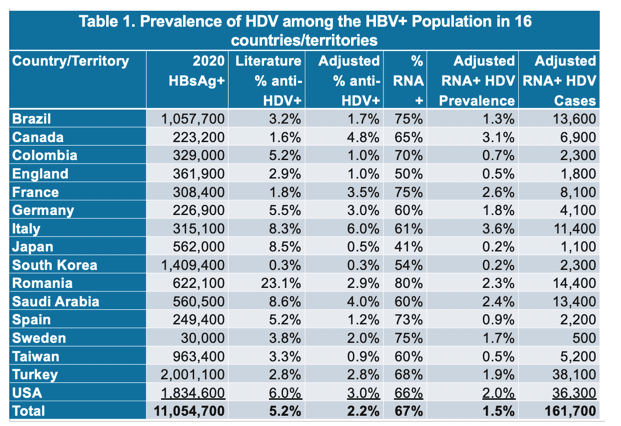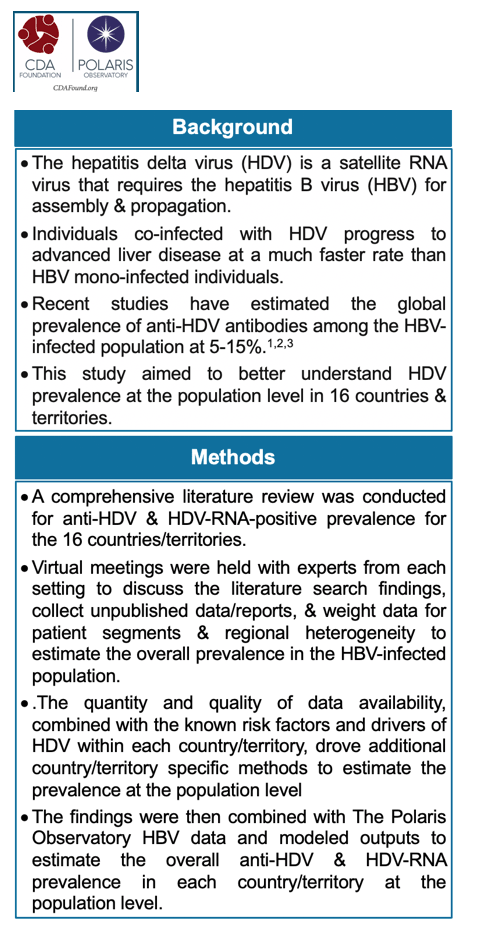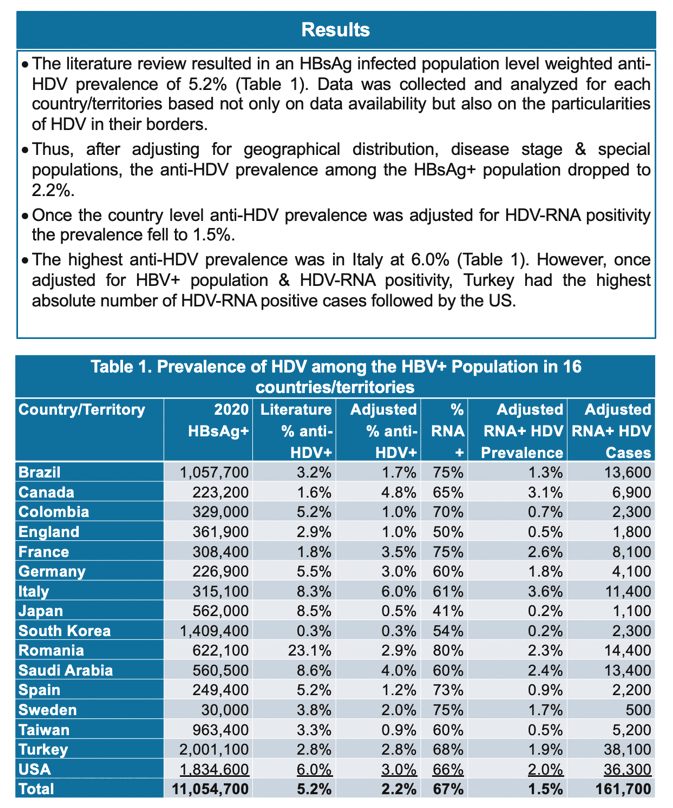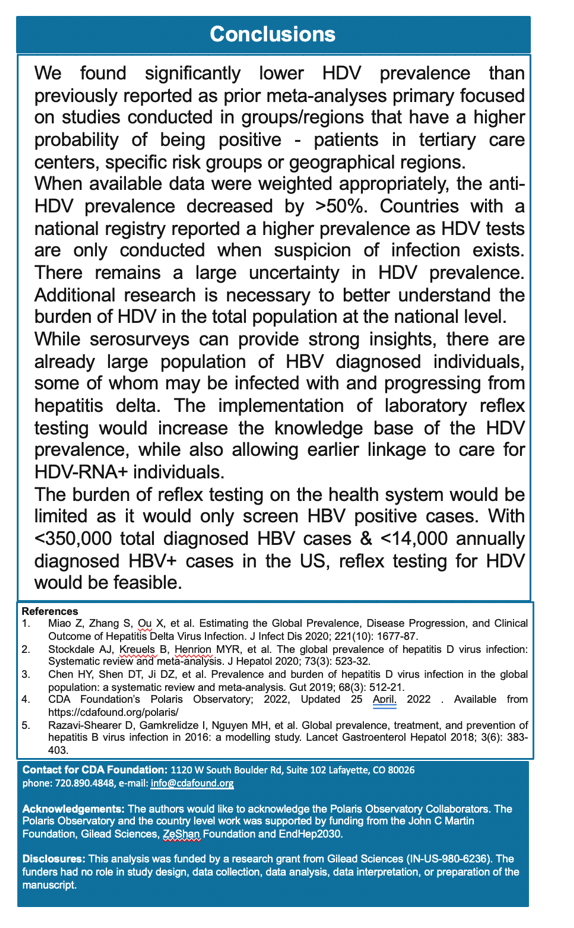 |
 |
 |
| |
Population adjusted prevalence of hepatitis
Delta virus in 16 countries and territories
|
| |
| |
AASLD Nov 4-8
Devin Razavi-Shearer, Karan Dhindsa, Homie Razavi
Center for Disease Analysis Foundation, Lafayette, CO, United States
HDV Prevalence Lower in 16 Countries Than Previous Research Suggests
AASLD-The Liver Meeting, November 4-8, 2022, Washington, DC
Mark Mascolini
Prevalence of hepatitis delta virus (HDV), a satellite virus in some people with HBV infection, appeared to be more than 50% lower in a thorough analysis of 16 countries [1]. Researchers from the Center for Disease Analysis Foundation in the United States determined that Italy has the highest adjusted prevalence among these 16 countries (3.6%), followed by Canada (3.1%) and France (2.6%). Overall adjusted HDV prevalence for the 16 countries came in at 1.5%, lower than the estimated 2.0% in the United States.
HDV has attracted much recent attention because people coinfected with HBV and HDV progress to advanced liver disease at a quicker pace than people infected only with HBV. Recent research sets global prevalence of anti-HDV antibodies in HBV-positive people at 5% to 15% [2-4]. Center for Disease Analysis researchers conducted this study aiming to reach a more nuanced estimate of HDV prevalence.
The analysis began with a comprehensive literature review focused on anti-HDV antibodies and HDV RNA prevalence in 16 countries on four continents: Brazil, Canada, Colombia, England, France, Germany, Italy, Japan, South Korea, Romania, Saudi Arabia, Spain, Sweden, Taiwan, Turkey, and the United States.
Next the researchers conducted virtual meetings with experts in each country to discuss findings in the literature, to collect unpublished data, and to weight data for patient groups and regional heterogeneity. Then for each country the research team considered quantity and quality of available data and known HDV risk factors in each country to develop additional country-specific methods to estimate HDV prevalence at the population level. They combined these country results with Polaris Observatory HBV data [5] to estimate overall anti-HDV and HDV RNA prevalence for each country at the population level.
In these 16 countries the refined literature review yielded an overall population-level weighted anti-HDV prevalence of 5.2% in people with hepatitis B surface antigen (HBsAg), an indicator that a person with HBV is infectious. When the researchers adjusted these findings for geographical distribution, disease stage, and special populations, anti-HDV prevalence fell to 2.2%. When they further adjusted country-level anti-HDV prevalence for HDV RNA positivity, the overall anti-HDV rate fell to 1.5%. Estimated anti-HDV prevalence rates after HDV RNA adjustment for each country were as follows:
- Italy 3.6%
- Canada 3.1%
- France 2.6%
- Saudi Arabia 2.4%
- Romania 2.3%
- United States 2.0%
- Turkey 1.9%
- Germany 1.8%
- Sweden 1.7%
- Brazil 1.3%
- Spain 0.9%
- Colombia 0.7%
- England 0.5%
- Taiwan 0.5%
- Japan 0.2%
- South Korea 0.2%
- Overall 1.5%

The researchers suggested they reached lower estimates of HDV prevalence than previously reported because prior meta-analyses tended to include studies in groups or regions with a higher probability of HDV positivity-like people admitted to tertiary care centers, specific risk groups, or specific regions. Another possibility is that the exhaustive methods these investigators devised yielded a more accurate estimate.
The Center for Disease Analysis team suggested that HDV reflex testing (an automatic anti-HDV antibody test on any sample that tests positive for HBsAg) "would increase the knowledge base of the HDV prevalence, while also allowing earlier linkage to care for HDV-RNA+ individuals." They argued that HDV reflex testing would not be overly expensive because fewer than 14,000 cases of HBV get diagnosed annually in the United States.
References
1. Razavi-Shearer D, Dhindsa K, Razavi H. Population adjusted prevalence of hepatitis delta virus in 16 countries. AASLD-The Liver Meeting, November 4-8, 2022, Washington, DC. Abstract 1004.
2. Miao Z, Zhang S, Ou X, et al. Estimating the global prevalence, disease progression, and clinical outcome of hepatitis delta virus infection. J Infect Dis. 2020;221:1677-1687.
3. Stockdale AJ, Kreuels B, Henrion MYR, et al. The global prevalence of hepatitis D virus infection: systematic review and meta-analysis. J Hepatol. 2020;73:523-532.
4. Chen HY, Shen DT, Ji DZ, et al. Prevalence and burden of hepatitis D virus infection in the global population: a systematic review and meta-analysis. Gut. 2019;68:512-521.
5. CDA Foundation. Polaris Observatory. The authoritative resource for epidemiological data, modeling tools, training, and decision analytics to support global elimination of hepatitis B and C by 2030. https://cdafound.org/polaris/



|
| |
|
 |
 |
|
|